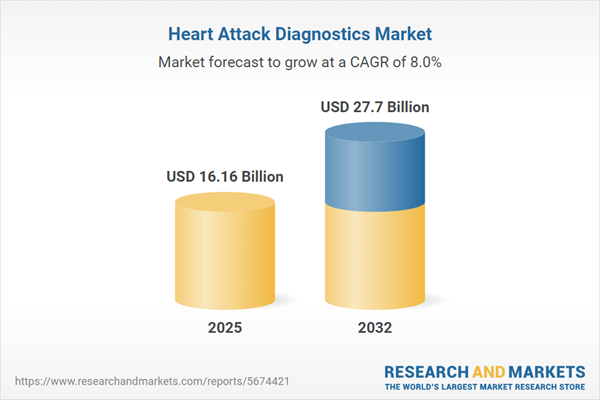Speak directly to the analyst to clarify any post sales queries you may have.
Senior decision-makers in healthcare are advancing cardiac care by prioritizing rapid, integrated, and precise heart attack diagnostic solutions. Strategic technology adoption is increasingly essential for driving both patient outcomes and organizational agility in today’s evolving market landscape.
Market Snapshot: Heart Attack Diagnostics Market Overview
The heart attack diagnostics market is valued at USD 14.96 billion and is expected to grow to USD 16.16 billion by 2025, with a projected reach of USD 27.70 billion by 2032 at an 8.00% CAGR. New investments in advanced diagnostics and digital integration are reshaping detection and workflow automation for healthcare organizations. These modern platforms address the demand for interoperability, simplify cross-functional strategies, and enable scalable and compliant care delivery across global regions.
Scope & Segmentation of the Heart Attack Diagnostics Market
- Product Type: Biomarker assays such as CK-MB, Troponin I, and Troponin T are core to early cardiac event identification and ongoing management strategies. Electrocardiography solutions ensure prompt detection, while advanced CT and MRI imaging facilitate comprehensive diagnostic pathways for diverse patient populations.
- Technology: High-sensitivity immunoassays accelerate laboratory diagnostics within acute care. Portable and point-of-care devices expand access to essential cardiac testing, making rapid diagnostics available in varied clinical and resource settings.
- End User: Hospitals, ambulatory care centers, diagnostic laboratories, and home healthcare settings are leveraging modular solutions to deliver personalized and efficient cardiac care, effectively managing acute and chronic cardiac conditions.
- Application: Rapid diagnostic tools enhance the identification and urgent management of cardiac episodes, while monitoring and risk assessment technologies bolster prevention and support chronic care planning.
- Regions: Distinct market dynamics exist in the Americas, Europe, Middle East and Africa, and Asia-Pacific, each shaped by localized regulations and clinical protocols. Key activity is evident in the United States, China, India, United Kingdom, Germany, and Australia, driven by varied healthcare infrastructure and tailored solutions to regional clinical requirements.
- Key Companies: Leading organizations such as F. Hoffmann-La Roche AG, Abbott Laboratories, Siemens Healthineers AG, Danaher Corporation, QuidelOrtho Corporation, Thermo Fisher Scientific Inc., bioMérieux SA, Becton, Dickinson and Company, Sysmex Corporation, and Koninklijke Philips N.V. are promoting industry innovation and building strategic partnerships to meet changing needs.
Key Takeaways and Strategic Insights
- Unified platforms that integrate biomarkers, imaging, and analytics improve collaboration among clinicians and enhance rapid care delivery in acute cardiac settings.
- Point-of-care diagnostic growth supports broader access and helps extend cardiac care services to under-resourced locations while ensuring consistency in higher-tier centers.
- Aligned workflows across diagnostic and care teams deliver more efficient management for high-risk patients, streamlining transitions between emergency care and ongoing management.
- Advanced digital infrastructure and refined assay deployment strengthen decision-making support, enabling adaptable responses to evolving regulatory and operational requirements.
- Regional differences continue to shape adoption: North America focuses on system interoperability, while Asia-Pacific advances tailored, cost-conscious strategies for scalable access to cardiac diagnostics.
- Collaboration in research supports faster implementation of new biomarkers and workflow technologies, reducing the time from innovation to patient care integration.
Tariff Impact and Industry Adaptations
Ongoing U.S. tariff shifts have prompted manufacturers in the heart attack diagnostics sector to diversify supply chains and refine procurement approaches. Healthcare providers are responding by building sourcing resilience, adjusting reimbursement models, and ensuring stable equipment availability to maintain consistent standards of cardiac care within evolving trade conditions.
Methodology & Data Sources
This analysis draws on perspectives from cardiologists, laboratory leaders, and policy authorities, benchmarking all findings against leading regulatory and industry standards. Rigorous validation measures ensure actionable guidance tailored for executive-level planning.
Why This Report Matters for Senior Decision-Makers
- Helps benchmark technology selection, supporting decisions aligned with care quality, compliance, and operational objectives.
- Enables strategic investment by matching emerging cardiac diagnostics with regulatory priorities and clinical demand shifts.
- Clarifies growth opportunities, facilitating resilient operations and strategic planning as market dynamics evolve.
Conclusion
Leveraging advanced heart attack diagnostics and interconnected clinical solutions positions healthcare organizations to meet new cardiac care challenges, enhance quality outcomes, and uphold operational consistency in an evolving sector.
Additional Product Information:
- Purchase of this report includes 1 year online access with quarterly updates.
- This report can be updated on request. Please contact our Customer Experience team using the Ask a Question widget on our website.
Table of Contents
3. Executive Summary
4. Market Overview
7. Cumulative Impact of Artificial Intelligence 2025
Companies Mentioned
The companies profiled in this Heart Attack Diagnostics market report include:- F. Hoffmann-La Roche AG
- Abbott Laboratories
- Siemens Healthineers AG
- Danaher Corporation
- QuidelOrtho Corporation
- Thermo Fisher Scientific Inc.
- bioMérieux SA
- Becton, Dickinson and Company
- Sysmex Corporation
- Koninklijke Philips N.V.
Table Information
| Report Attribute | Details |
|---|---|
| No. of Pages | 187 |
| Published | November 2025 |
| Forecast Period | 2025 - 2032 |
| Estimated Market Value ( USD | $ 16.16 Billion |
| Forecasted Market Value ( USD | $ 27.7 Billion |
| Compound Annual Growth Rate | 8.0% |
| Regions Covered | Global |
| No. of Companies Mentioned | 11 |









